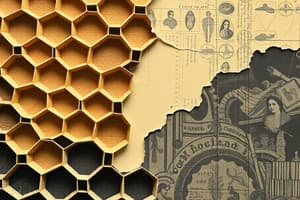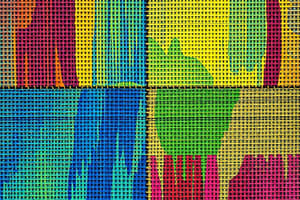Podcast
Questions and Answers
Why can Move No. 1 never be selected?
Why can Move No. 1 never be selected?
- It is 1 less than the weave repeat
- It is a multiple of the weave repeat (correct)
- It is not a factor of the weave repeat
- It is equal to the weave repeat
Which two Move Nos. can be used according to the text?
Which two Move Nos. can be used according to the text?
- Move No. 1 and Move No. 3
- Move No. 1 and Move No. 2
- Move No. 3 and Move No. 4
- Move No. 2 and Move No. 3 (correct)
How is the first warp end marked in the given weave?
How is the first warp end marked in the given weave?
- First end is filled with 4 down and 1 up
- First end is filled with 2 up and 3 down
- First end is filled with 3 up and 2 down
- First end is filled with 4 up and 1 down (correct)
How is the second end filled using Move No. 3?
How is the second end filled using Move No. 3?
How is the third end filled using Move No. 3?
How is the third end filled using Move No. 3?
What is marked in the adjacent right box of the second and third ends after the counting of Move No. 3 is completed?
What is marked in the adjacent right box of the second and third ends after the counting of Move No. 3 is completed?
What is the defining characteristic of an Irregular Satin/Sateen Weave?
What is the defining characteristic of an Irregular Satin/Sateen Weave?
Which of the following is an example of a Regular Warp Satin?
Which of the following is an example of a Regular Warp Satin?
What is the defining characteristic of a Weft Sateen?
What is the defining characteristic of a Weft Sateen?
Which of the following is an example of an Irregular Weft Sateen?
Which of the following is an example of an Irregular Weft Sateen?
What is the difference between Regular Warp Satin and Irregular Warp Satin?
What is the difference between Regular Warp Satin and Irregular Warp Satin?
What is the difference between Standard Irregular Satin and Standard Irregular Sateen?
What is the difference between Standard Irregular Satin and Standard Irregular Sateen?
What is marked in the adjacent right box of the second end after the counting of Move No.2 is completed?
What is marked in the adjacent right box of the second end after the counting of Move No.2 is completed?
How many down (Blank Boxes) are filled after the Up (Coloured Box) in the first end to start filling the second end?
How many down (Blank Boxes) are filled after the Up (Coloured Box) in the first end to start filling the second end?
In the given weave pattern, how many Warp Ends are filled with Up (Coloured Box) in the first round?
In the given weave pattern, how many Warp Ends are filled with Up (Coloured Box) in the first round?
What marks the adjacent right box of the third end after Move No.2 is completed in filling the third end?
What marks the adjacent right box of the third end after Move No.2 is completed in filling the third end?
How many down (Blank Boxes) are filled after the first Up (Coloured Box) in the second end to start filling the third end?
How many down (Blank Boxes) are filled after the first Up (Coloured Box) in the second end to start filling the third end?
In completing a repeat, which End will be filled after the fifth End?
In completing a repeat, which End will be filled after the fifth End?
What is the purpose of the 'up' (colored) box in the text?
What is the purpose of the 'up' (colored) box in the text?
How many ends are described in the text to complete a repeat?
How many ends are described in the text to complete a repeat?
What is the purpose of the 'down' (blank) boxes in the text?
What is the purpose of the 'down' (blank) boxes in the text?
What is the difference between 'S-Satin' and 'Z-Satin' described in the text?
What is the difference between 'S-Satin' and 'Z-Satin' described in the text?
Which of the following is NOT mentioned as an application of satin weaves in the text?
Which of the following is NOT mentioned as an application of satin weaves in the text?
What is the definition of a 'Regular Satin/Sateen Weave' according to the text?
What is the definition of a 'Regular Satin/Sateen Weave' according to the text?
In a 4/1 (5 - End) Satin weave with Move No. 2, how is the second warp end filled?
In a 4/1 (5 - End) Satin weave with Move No. 2, how is the second warp end filled?
In a 4/1 (5 - End) Satin weave with Move No. 2, how is the third warp end filled?
In a 4/1 (5 - End) Satin weave with Move No. 2, how is the third warp end filled?
In a 1/4 (5 - End) Sateen weave with Move No. 2, how is the first warp end filled?
In a 1/4 (5 - End) Sateen weave with Move No. 2, how is the first warp end filled?
What is the significance of the 'Move No.' in the weave pattern?
What is the significance of the 'Move No.' in the weave pattern?
In a 4/1 (5 - End) Satin weave with Move No. 2, how many ends are there in a complete repeat?
In a 4/1 (5 - End) Satin weave with Move No. 2, how many ends are there in a complete repeat?
In a 1/4 (5 - End) Sateen weave with Move No. 2, how would you fill the second warp end?
In a 1/4 (5 - End) Sateen weave with Move No. 2, how would you fill the second warp end?
Flashcards are hidden until you start studying
Study Notes
Satin and Sateen Weaves
- Satin and Sateen weaves are classified based on the prominence of warp or weft floating on the fabric surface.
- Warp Satin: If the prominence of warp floating is seen on the fabric, then this Satin is called Warp Satin.
- Regular Warp Satin: Produced with a definite move number throughout the repeat.
- Irregular Warp Satin: No definite move number to construct the Irregular Satin throughout the repeat.
- Weft Sateen: If the prominence of weft floating is seen on the fabric surface, then this Sateen is called as Weft Sateen.
- Regular Weft Sateen: Produced with a definite move number throughout the repeat.
- Irregular Weft Sateen: No definite move number to construct the Irregular Weft Sateen throughout the repeat.
Filling Weave Repeats
- To fill the second end, counting of Move No. starts from 1st up (Coloured Box) after down (Blank Box) in the first end within the same repeat.
- To fill the third end, counting of Move No. starts from 1st up (Coloured Box) after down (Blank Box) in the second end within the same repeat.
- In the same way, fourth and fifth Ends are filled to complete the repeat.
Examples of Satin and Sateen Weaves
- 4/1 (5 - End) Satin with Move No. 2 (Fig. 2)
- 1/4 (5 - End) Sateen with Move No. 2 (Fig. 3)
- 4/1 (5 - End) Satin with Move No. 3 (Fig. 1)
- 1/4 (5 - End) Sateen with Move No. 3 (Fig. 4)
Irregular Satin/Sateen Weave
- If Satin/Sateen Weave having no particular move number is called as Irregular Satin/Sateen Weave.
- Examples of Irregular Satin/Sateen Weaves:
- 3/1 (4 - End) Satin
- 5/1 (6 - End) Satin
- 1/3 (4 - End) Sateen
- 1/5 (6 - End) Sateen
Direction of Diagonal Lines of Satin/Sateen Weave
- These Weaves (Satin/Sateen) can be produced in both 'S' and 'Z' direction.
- For 4/1 Satin: Move # 3 is used to make S-Satin, and Move # 2 is used to make Z-Satin.
- For 1/4 Sateen: Move # 3 is used to make Z-Sateen, and Move # 2 is used to make S-Sateen.
Applications of Satin and Sateen Weaves
- Satin weaves find a wide range of application such as:
- Denim
- Interlining Cloth
- Ribbons
- Dress materials (lustrous)
- Children Dress materials
Studying That Suits You
Use AI to generate personalized quizzes and flashcards to suit your learning preferences.




